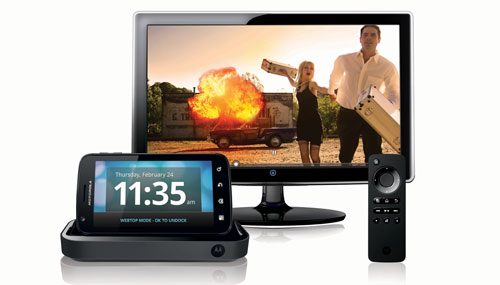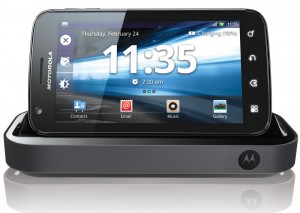
With the recent announcement that Android developer Google is acquiring Motorola Mobility, the US handset manufacturer is expected to enjoy more attention than it has in recent years. If its most recent smartphone, the Atrix, is anything to go by, the competition had better be paying attention.
The Atrix, like a number of recent smartphones from other manufacturers, includes a glorious, bright and large screen. The 4-inch, 540×960-pixel, capacitive-touch display is excellent and offers vibrant colours.
Boasting a dual-core 1GHz processor and 1GB of RAM, what really impresses is the inclusion of 16GB of internal memory. This can be expanded with an additional 32GB via the microSD slot beneath the battery, meaning it’s possible to have as much as 48GB of storage. Considering the Atrix’s media functionality, you might need it.
Running Android 2.2, the Atrix is positioned as both a powerful business tool and an entertainment device. It includes a 5-megapixel rear-facing camera complete with dual-LED flash and the ability to shoot 30 frames per second video at 720p. There’s also a low-resolution front-facing camera for video calling.
In terms of connectivity, the Atrix has everything you’d expect: GPS, Bluetooth, Wi-Fi, the ability to operate as a wireless hotspot and support for GPRS, Edge and 3G. It’s also got a few extras, like native DNLA networking support for streaming content to a TV and even a mini-HDMI port. Motorola has also been thoughtful enough to include a mini-HDMI to HDMI cable.
The mini-HDMI port is situated next to the microUSB slot used for connecting the device to a PC or for charging, and there’s a good reason for this. A dock comes supplied with the Atrix — at least in SA — and the phone connects to it for both power and to output to an external display.

The decision to include the dock is an inspired one and really demonstrates just how capable a device the Atrix is. With an HDMI output, 3,5mm audio jack and three USB ports, the dock allows you to turn the Atrix into an entertainment centre or even a rudimentary desktop computer once a keyboard mouse and USB drive have been hooked up.
Upon connecting the handset to the dock one is presented with the option to enter either desktop (“Webtop”) or entertainment (“Entertainment Centre”) modes. The former creates a Windows-like desktop from which users can browse the Web via Firefox, create and edit documents, or do most other things one would expect of a basic netbook.
In entertainment mode, the Atrix can play video or audio or view images as slideshows through a capable and well laid out interface. To make things even easier, the dock includes a remote control that is as useful for controlling media as it is for controlling a slideshow presentation.
We weren’t blown away by the desktop mode — it works, but it’s somewhat clumsier than working on a traditional laptop and one soon runs into limitations in terms of what sort of progams the Atrix can run.
The entertainment mode, however, is fantastic, primarily because of the slick interface and the supplied remote control. As a set-top entertainment centre, the Atrix is superb.
It’s also possible to access much of the handset’s functionality from the dock to send SMSes, look up and call contacts — via the speakerphone — and still use it as a desktop equivalent simultaneously. Users can remove the handset from the dock at any time and upon reconnecting it the device returns to its previous state.
If the dock isn’t portable enough, Motorola has also created what it calls a “lapdock”. Essentially a “dumb” netbook with battery, the lapdock works in a similar fashion to the dock, except that it includes an 11,5-inch screen and keyboard. The handset slots into the rear of the device and is charged by the lapdock’s own battery.
We particularly liked the inclusion of a biometric fingerprint reader, so those looking for added security can use a fingerprint to unlock the phone rather than a Pin.

The latest version of Motorola’s custom user interface for Android, called Motoblur, is pleasantly understated and a vast improvement from the busyness that plagued earlier iterations. It includes the ability to view all seven home screens as thumbnails — as seen on HTC Sense-based handsets — which is a welcome addition and makes navigating the device that much faster.
Annoyingly, one has to sign up for a Motoblur account when setting up the device, but this is a minor gripe. Thereafter, Google users can set up their account and minutes later enjoy access to Gmail, Google Talk and their Google contacts. This seamless integration with Google also means the Atrix supports Google Maps Navigation out of the box, making it a capable GPS navigation device.
Despite its sizeable screen, its rounded corners and 11mm thickness make the Atrix as comfortable in a pocket as it is in hand. Also, despite its large battery, the device weighs just 135g. And battery life is surprisingly good, with the device lasting around three days with light to moderate use and full day and a half with intensive use. That’s better than we’ve seen from most similar devices currently on the market.
The Atrix is a potent device and provides the most responsive interface and speedy handling we’ve seen from a high-end Android smartphone to date. The sizeable onboard memory and expansion capabilities also mean that entertainment junkies finally have a handset capable of keeping up.
With a recommended retail price of R5 000, the Atrix is also excellent value for money and competitively well priced. If this is what Motorola can achieve without Google, one has to wonder what to expect once the two companies start working more closely together. We’re pretty excited about finding out. — Craig Wilson, TechCentral
- Subscribe to our free daily newsletter
- Follow us on Twitter or on Facebook




